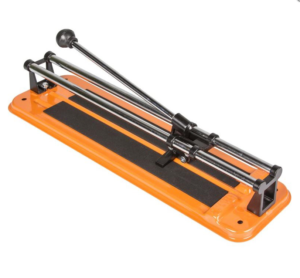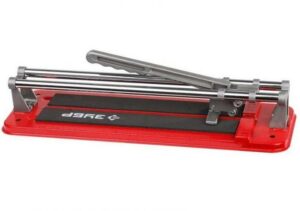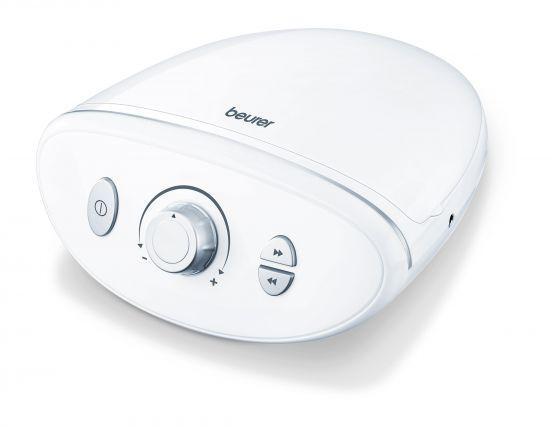Rating of the best manual tile cutters: which one to buy for porcelain tiles, review

creativecommons.org
Throw away the times when you used an ordinary Soviet glass cutter when laying tile materials. The glass cutter often caused more damage than good: cracking tiles, a high ratio of defective parts, uneven cutting. Now in the store you can find dozens, if not hundreds of good manual tile cutters, differing in cost and performance. What is the best tile cutter – we’ll talk about it in our article.
It is important to immediately note that a special tool is used to lay porcelain tiles, because the material is several times stronger and harder than ordinary tiles. Let's talk about this in detail.
The content of the article
The best tile cutter for porcelain tiles - features of the tool
As we said earlier, even the best manual tile cutter will not work for porcelain tiles. To cut it, you can use the following devices:
- For everyday use, a manual version of a cutter with diamond wheels is perfect. For small batches of tile material - an ideal and inexpensive solution. The percentage of defects is much lower than with a glass cutter. Remember also that the tool becomes dull when working: the more tiles you cut, the more you need to process the edges. The advantage of such equipment is that it immediately has a device for splitting tiles.Among the disadvantages: poor cutting at corners, and even then only in inexpensive models.
- Electric tile cutter. An expensive option for professionals – when you need to cut material quickly and in large quantities. Models differ in engine location: top or bottom. The diameter of the cutting edge installed on the equipment depends on this. For hard porcelain stoneware, nozzles in the form of diamond wheels are suitable. The undeniable advantage of the material is less chipping and fine cutting.
If you want to use an angle grinder, you will get extremely disappointing results. The joints are uneven, and the chipping rate increases several times. Therefore, working on porcelain stoneware with an angle grinder is an extreme situation. Another disadvantage of using the tool is a large amount of dust when cutting.
Review of the pros and cons of manual tile cutters
The classic version of the tool resembles pliers with a tip made of hard material (the best is diamond). The design and method of operation are no different from a conventional glass cutter. The tool is inexpensive (because it is manual), but requires dexterity and skills to obtain a high-quality result. To mark the cutting line, use a square or ruler. The tile is cut along the front edge. Next, after several pressings with a tile cutter, the parts are broken off. To obtain a narrow strip of material, use small jaws similar to pliers. The tool is used primarily for thick porcelain tiles. The cutting thickness is about 8 mm.
A simple tool has the following advantages:
- small sizes;
- low price;
- you can make a circular cut;
- no noise from the engine (because there is none);
- since the blade moves slowly, no dust is generated;
- unlimited cutting area.
But there are also disadvantages of good tile cutters:
- skill required;
- the percentage of defects is higher than that of mechanical ones;
- edges require polishing;
- working with your hands requires more time and effort.
Which manual tile cutter is better to buy?
For craftsmen, the best option is to immediately look for an electric tool. It’s much easier and faster for them to work. At home, use a manual analogue due to its low cost. Before purchasing, identify several important parameters for yourself:
- Dimensions. The tile cutter bed must match the length of the tile material.
- The stronger the components and parts, the longer they will serve “faithfully.”
- Tile cutters with bearings are a little more expensive, but they are much more pleasant to work with. As a result, the device has a longer service life, and the cutting lines are smoother. Advanced devices have 6 bearings at once.
- Equipped with circular cutters for the tile fastening mechanism, measuring tools - additional “chips” that simplify the work.
Rating of manual tile cutters for porcelain stoneware
Based on user reviews online, we have compiled a small top list of manual tile cutters. It is not necessary to choose exactly one of them, but this can be an example for purchasing your own equipment.
Zubr 33191-40

creativecommons.org
Main advantages:
- Two metal guides reinforce the structure and securely secure the cutting roller and handle. The cut will be smoother than without such reinforcement.
- There is a heavy platform with holes for installation on a table or other flat surface; stiffening ribs for operation under increased loads.
- The handle is wavy. What this gives you: your hand will not slip when cutting, and it also improves operating comfort.
- The cutter has a rubberized coating - the tiles will definitely not twitch or slide off.This means the quality of the seam improves.
- The cutting roller is a tungsten-carbon alloy. It is one of the materials, along with diamond, that has greater strength than standard cutting materials.
Zubr 33195-60
In the rating of manual tile cutters there is another option from Zubr. The tool is of very high quality, so it deserves the attention of buyers. Its main advantages:
- The large length (400 mm) allows you to cut tiles lengthwise and at angles.
- The carriage moves smoothly on a bearing system. An accurate and even seam is guaranteed.
- Rollers can be replaced; this allows you to work both on ordinary material and on porcelain stoneware.
- All working elements are made of an alloy of tungsten and carbon - we have already talked about it earlier.
- The design of the device has rigid metal inserts and rubber rings for greater grip on the surface. And the holes in the tile cutter allow you to install it on a table for greater convenience.
Zubr 33193-60-Z01
It’s hard to say that any other company can make it into the ranking of tile cutters for porcelain stoneware – “Zubry” doesn’t let anyone relax. The main points of this model:
- The device has a large incision thickness - from 5 to 16 mm. You can cut at any angle.
- Attaches to an aluminum platform and has rigid iron inserts. Using fasteners, you can install the knife on a table or workbench.
- The support bearing system smoothly moves the cutting edge along the surface of the tile.
- There is equipment for breaking the material: you can perform the action at any point in the cut.
- The set includes a convenient transport bag.
Stayer 3305-60_z01
You will be surprised, but “Zubr” is not in the ranking of the best manual tile cutters. Let us note the main qualities of this tool:
- The main purpose of the device with a reinforced cut is thick seams and breaks on any surface.
- The cutting edge is an alloy of carbide and tungsten. Another durable material that ensures long-term use of the tool.
- Increased cutting length – 600 mm. Allows you to work both on tiles and glass.
- Has a fixing bar for firmly installing the plate under the edge.
- The tile cutter carriage moves very smoothly – a 6-bearing system is responsible for this.
STAYER 3310-60
Main advantages of the device:
- The design is equipped with a flat bar for cutting materials diagonally.
- Parallel channels maintain a high-quality and even seam.
- Radial holes can be made using a circular knife. It is convenient to make holes for switches or sockets.
- The main part has rubberized inserts - the tile will not move anywhere from the knife.
- A built-in ruler is designed for accurate measurements.





